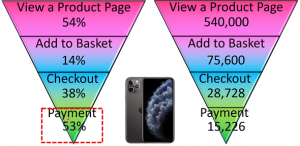By Emily Black, Content Executive and Analyst at IMRG
There was a time when retailers were asking whether devices such as tablets, kindles, and Apple watches would take over the market for online shopping. However, with similar questions regarding the metaverse and virtual reality on some retailers’ minds, it seems as though mobile commerce has come to dominate as a platform, while some other technological advances have achieved far lesser impact on our lives. Whilst some shoppers might make purchases through a variety of mediums, smartphones continue to prevail. Retailers understand the longevity of mobile commerce, so how can they optimise their sites in order to help customers get the most out of smartphone shopping?
Throughout the pandemic, mobile commerce has seen similar growth patterns to the rest of the online retail market. In 2020, growth was astronomically high, reaching unprecedented levels with highs of +60%. However, in mid-April 2021, growth plummeted when the high street reopened, drawing customers back to in-person shopping habits. Because of this, online growth couldn’t build on the exponential levels it had seen the year before, as less people were shopping on their mobile devices.
Understanding these patterns of high growth during the lockdowns, and the resultant negative growth the following year, we can then take a look at how retailers can ensure they optimise their mobile sites.
Data from IMRG’s smartphone optimisation study* shows that 54% of visits to retail sites will look at a product page, 14% of those will add to basket, then 38% will then make it to the checkout, and only 53% of these customers will actually make the payment. This means that the industry average is that for a retailer fortunate enough to attract 1,000,000 visits, only 15,226 people will checkout and pay (though there is some variation on that figure depending on where the site visit begins).

Here are three ways that retailers can ensure a seamless customer journey, to maintain loyalty, observe a strong performance, and ultimately convert customers to the checkout.
1. Optimise your checkout
IMRG’s data* shows that only 53% of smartphone shoppers who start the checkout process actually complete it, meaning retailers are losing out of 47% of customers at the final stage.
We ordered a group of retailers by the percentage of customers who actually check out, in order to find out what the most successful checkouts looked like. We found from this data that the most successful mobile checkouts were likely to include features such as:
- Free delivery, including over a certain monetary threshold
- Only 3 pages to get them through the checkout itself
- The option to use PayPal to check out
- ‘Pay now, and confirm order’ messaging instead of ‘Pay now’ which was seen as aggressive
2. Optimise your product display page
Similar to the checkout page, it’s vital to ensure that the product display page is optimised for mobile shopping when customers land on your site. So how exactly can we ensure customers have the best chance of adding the product to their basket, or continuing to browse? In the same study, we found out what the display pages which obtained the most traffic included these features:
- Links to products from the home page (improves SEO)
- ‘Multiple image cycle’ on the product page, which is where hovering the mouse on an image cycles through various pictures of the product
- Including category pages for SEO
3. Include a variety of mobile payment options
Customers love to have variety, as there’s nothing worse than getting stuck at the last stage. To ensure that shoppers have a payment method that suits them, it’s important to offer a range of ways to pay. The IMRG smartphone optimisation study found that the most successful mobile checkout pages offered a wide range of payment options, even if they weren’t necessarily used very often. Generally, retailers with the highest conversion rate from checkout to payment offer functions such as:
- PayPal – Can offer buy now, pay later, or easy login
- Apple Pay – Offers quick checkout with Apple ID
- A form of buy now, pay later
We then asked a group of industry experts for their opinions about how to optimise the mobile commerce experience.
Naji El-Arifi, Head of Innovation at Wunderman Thompson Commerce said, “One thing we can be sure of is that new channels will come to market that entice, excite and encourage consumers to adopt new technologies like we saw with smartphones and tablets. This has happened time and time again, from iPad and Android devices to newer innovations such as voice-activated gadgets and smartwatches. And this constant innovation warrants online retailers to always look ahead and prepare strategies that support upcoming market trends. Although this foresight will require both time and money, when done correctly it can offer a competitive advantage and deliver a long-term return on investment (ROI). A tip that will stand retailers in good stead is making sure they have a fully responsive web experience and think about moving to a headless and API first style of development, which allows agility and reactivity to the changing digital channels.”
Rory O’Connor, Founder and CEO of Scurri suggested, ‘The surge in popularity for ecommerce in recent years can be attributed to a huge variety of factors, but it is hard to ignore the added convenience that tablet and mobile device use has given to this mode of shopping. It has never been easier to place an order online in seconds, and while usability via laptop may be clearer, more portable devices have afforded many consumers the luxury of really having whatever they desire at their fingertips. It has recently been reported that more than half of all internet traffic comes from mobile usage, and retailers need to tap into this to perform best.

Clearness of your site, design and aesthetics, and customer service all play an integral part, and to not pay attention to every aspect of the customer journey may just make a shopper switch off before the point of purchase. The website has to be seen as both a storefront and the world’s best sales assistant in that it is great if they can get people in the door, but better if they can get them out the door with their bags full. The design should be pleasing and fit the desired aesthetic in a coherent way, but it also must be accessible – especially as so many people never shopped online before, the flow from adding to cart to the point of purchase should be easy and clear. Online retailers must adapt and change the design of their website so that it is just as easy and pleasing on mobile, tablet or laptop.”
Thomas Kasemir, Chief Product Officer at Productsup observed that, ‘With the speed at which new devices come to market, the debate of whether mobile or tablet devices perform better today is somewhat pointless. It won’t be long before some new technology enables us to shop in a completely different format – take AR glasses for example. Instead of focusing on optimizing per device, brands and retailers need to start thinking about how they can streamline the process of managing product information flows. A new management approach identified by Constellation Research, product-to-consumer (P2C), simplifies how retailers tailor shopping experiences for various channels and devices.”
Alex Vaidya, CEO of StoryStream noted that, “The trajectory appears to be more and more mobile, and it’s perhaps for that reason that brands are spending more and more time investing in technologies that make small bits of digital real estate work harder. Seeing the principles of, for example, a good social media strategy being adopted as the foundation of a good mobile strategy has been a particularly interesting phenomenon. Those two worlds continue to converge; there’s perhaps no better an example of a compelling mobile experience than social platforms and the content creators on them. The lessons learned on social are now helping retailers drive commercial performance on their own websites.”
Naomi Botting, Field Marketing Specialist at Lengow commented, “It is no surprise that smartphone performance is doing increasingly well. 80% of the British population is active on social media In the UK, a third of internet users say they have already bought a product via a social media platform. Everyone’s talking about TikTok and the growing presence of social media in e-commerce. It’s not just TikTok, Instagram is the most influential platform for online fashion, with clothing brands averaging 13.71 interactions per 1000 followers. Social commerce sales are expected to nearly triple by 2025, with more than one-third of Facebook users planning to make a purchase directly through the platform in 2022. It won’t stop there… The hype around metaverse continues, with funding pouring in from investors. Shopify announced that products sold online that use 3D and AR technology have a 94% higher conversion rate.”
To find out more about how to optimise your site, with instructional videos backed by data, take a look at IMRG’s Optimisation Guides.
*All data is sourced from IMRG’s smartphone survey conducted in February, March, and April 2020.
Published 26/04/22


